| Introduction
You may wonder why most of the photos on
this page are "real" locomotives. The reason is,
if you know what a photo looks like of a real
locomotive then you will have a better chance of
making a photo of a G-Scale locomotive look much
the same.
|
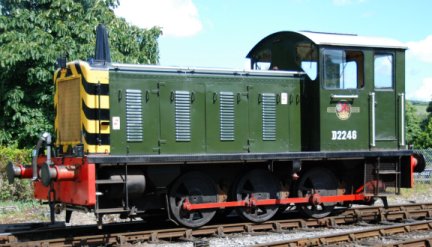 |
|
|
| Camera
Angle
If you look at photos in magazines or at
video on say "YouTube" you will see
photographs and videos of Garden Railways and they
almost always have one thing in common.
The camera angle is low down, as if at
your eye level above the level of the track, or
even below sometimes called "the worm's eye shot".
Why? Well this camera angle gives the
same view as if you had been standing taking a
photo beside the track of a full sized locomotives
and trains, thus adding to effect of realism in
your photo or video.
The photo is of a full sized loco taken
at track side level on the Buckfastleigh to Totnes
line.
|
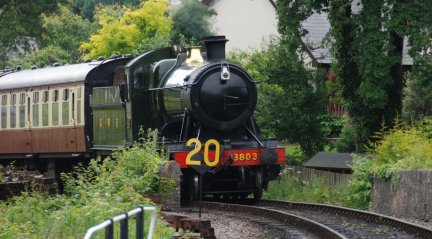
|
|
|
|
There are times when a following shot as
if in a helicopter is dramatic but rarely better
than the low level shot. If
you are using a video camera the best advice is
use it like a still camera and follow the
subject's movement rather than moving the camera
all over the place. With that in mind if a video
camera is not mentioned below then use is like a
still camera.
The photo, whilst it is of a full sized
loco, is actually taken from way above unit and
looks more like a shot of a model loco standing in
a station. It does not have the impact of a lower
eye level shot.
|
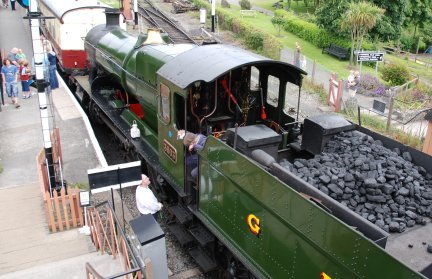
|
|
|
| Equipment
Forget for a moment the camera, still or
video, and think that it is a dry but cold day and
you are wishing to capture the "great" picture of
your live steam or electric locomotive, then
the most important item to have with you is
something to put down on the ground so that you
can lay flat on the ground. Make sure it is not
just any old piece of plastic sheeting as it will
be very cold to the touch! A Sleeping bag on top
of a ground sheet is what you need to be the most
comfortable.
A more expensive camera does not
necessarily mean a better shot but obviously a
better camera which allows you to use photographic
techniques, to the full, does result in stunning
photos. You must expect to take many photos at
different setting to, may be, arrive at the shot
you really wanted to obtain.
However do not be put off if you do not
have a digital single lens reflex camera (DSLR) as
the simple point and shoot camera can give you
good results but take your time experimenting with
all available settings.
The photo was taken at Totnes
Littlehempton Station as low down as possible. Had
this been a G-Scale loco it would have
necessitated lying flat on the ground as mentioned
above!
|
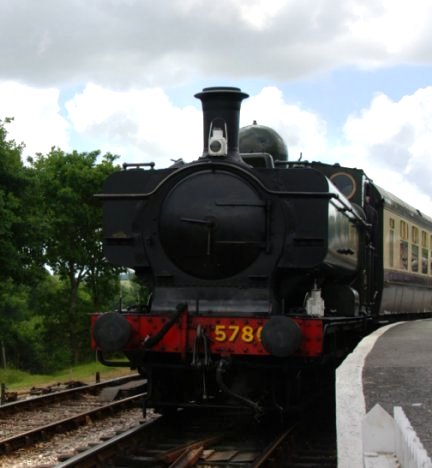
|
|
|
| Moving
or still locomotives
Your next decision is do you want to take
a shot of the locomotive stationary or moving.
Both are correct but it all depends upon what
photo you are wanting. There will not be the
characteristic flowing of steam from the chimney
back over the engine if a live steam loco is not
moving. The photo shows a
full sized loco at speed with the lovely plume of
steam leaving the chimney.
It is always best to use a tripod but
with the DSLR camera some now have "vibration
reduction" lens that reduce camera shake. Pan with
the subject, whilst pressing the shutter release,
if you are taking a shot of a moving
locomotive and you can achieve the photo, which to
some is most pleasing, with foreground and
background blurred due to camera movement and the
subject still.
Such a photo is not as easy to achieve
with a compact digital camera as with the DSLR.
With the DSLR there is negligible delay between
the shutter release being pressed and the picture
being taken and entered into the camera's memory.
|
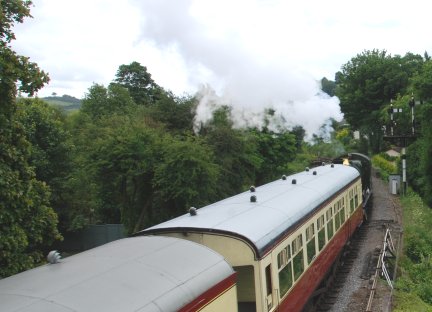
|
|
|
|
The photo is of the indoor "00" railway
track at Buckfastleigh, the loco is moving so the
camera was panned with the movement resulting in
the blurring of foreground and back ground.
|
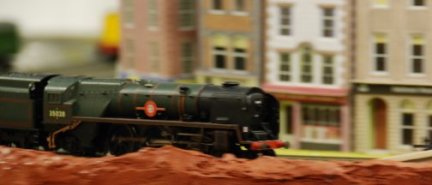
|
|
|
|
There is nothing wrong in taking at least
some shots with the loco stationary and this is
especially true when using a compact digital
camera.
Having the loco stationary also means
that the camera can be mounted on a tripod and
foreground - subject - and background will not be
blurred but as shown here with careful use of the
depth of field the foreground and back ground are
mostly out of focus making the loco the important
item in the photo.
The DSLR such as the Nikon D80 has
another nice feature in that you can take a
succession of photos just by holding down the
shutter release button. This combined with panning
the camera with the moving loco can achieve great
results.
|
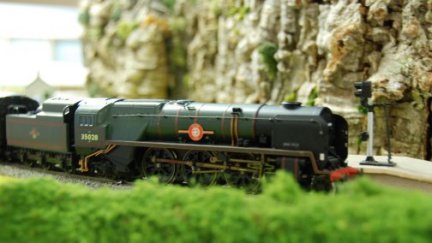
|
|
|
| Day
or night shots
Day shot are as above but the night time
shot will mean even more experimentation. Whether
you have a compact camera or DSLR. To achieve that
natural looking picture you must NOT use the built
in flash ... or any flash for that matter unless
you are setting up a studio like location but such
a set up is far outside the scope of this piece.
In the, top right, picture of the "00"
track at Buckfastleigh the interior light of the
diesel shows nicely, foreground and background
blurred, loco in focus and still, showing that the
camera was being panned at the speed of the loco
when the shutter release was pressed.
Nights shots are all about embracing the
feel for the environment and using available
light. Now this does not mean a completely black
night shot as there must be some light for the
camera to record an image. The light can be from
moon light, street / station lights . So first
take some shots with just the existing light using
the capabilities of your camera to the full.
The night shots you have seen taken in a
movie / TV film are specially contrived by the
lighting crew who have been there for a long time
setting the lighting for the prefect shot.
So there is nothing wrong in you copying
those ideas of using additional lights. Simple
lights such as those used with protection for the
bulb are quite sufficient for first your efforts
and then build on your results.
The night shot of the building and loco
allows the lights of the building to
illuminate the general area and is not "over lit"
with lights outside. You will need to achieve a
balance between the outside ambient light and that
coming out from the windows.
|
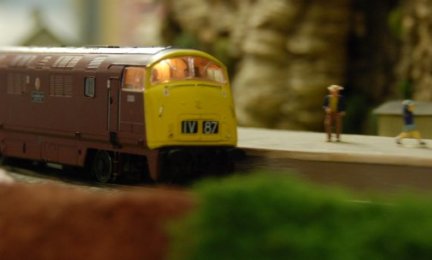
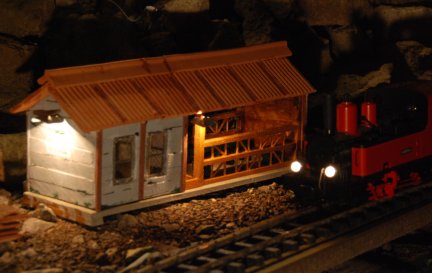
|
|
|
| Special
shots for the Video camera
Something that the video camera can do
that the still cannot and that is record a trip on
your track. Whether the camera is facing forwards
or backwards make sure it will be safe even if the
train has a crash. Keep the camera located as near
to the track as possible, and this helps with
preventing the truck carrying the camera from
turning over and does give you the shot as if it
were on board a real train.
Remember to consider any tunnels, bridges
or track side furniture such as signals so that
the camera does not smash into them and stop your
fun before it has begun.
Here is a shot taken from a full sized
train whilst stationary waiting at signals. Such a
photo could be taken on your railway with a camera
on a suitable truck.
|
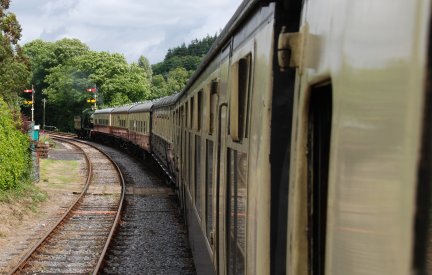
|
|
|
| Conclusion
Whether you have a still compact or
digital single reflex camera or a video camera
make sure you will be comfortable taking the
photos, enjoy the task and if the results are not
as you want the first time make some notes and
then try to improve the next time.
Always consider
your safety whilst taking your photos
especially when using additional lighting and
trailing cables, we cannot be responsible for
your accidents.
If the best photo you can take is like
this one, taken from the foot bridge at
Buckfastleigh Station, be satisfied as the steam
makes for a very atmospheric photo.
Well that is enough for the time being
but of course is not the end of the topic as there
is so much more to consider especially for the
owner of a DSLR but to go on would probably bore
most readers !!!
|
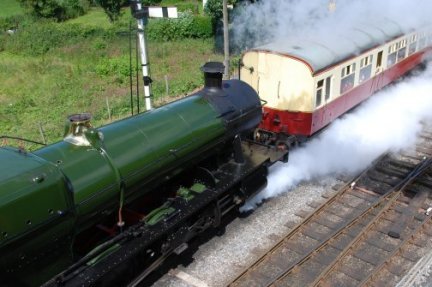
|
|
| The
photographs of the locos on this web page were taken
on the South Devon Railway ...
The animation is made up of 23 separate
photos assembled at low resolution to show all the
photos taken whilst panning and then you could
decide which is the shot you like most.
Camera Nikon D80 with VR 18-200m lens,
shooting mode - continuous 3 frames per second.
|
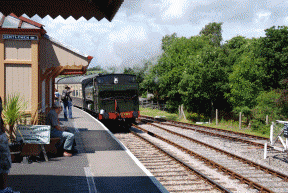
|
|
|

